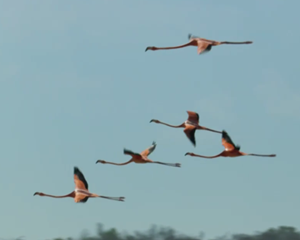Concentrated by the tropical sunshine, the brine in these shallow lagoons cannot be tolerated by most animals.
在热带阳光的照射下,大多数动物都无法忍受浅泻湖中的咸水。
And yet, these Caribbean flamingos have flown hundreds of miles to gather here.
然而,这些加勒比火烈鸟飞跃了数百公里,聚集在此。
These hypersaline waters keep many predators at bay... so it's here they choose to nest.
这种高盐度的水使很多捕食者望而却步,因此它们选择在这里筑巢。
There are more than 10,000 pairs here. It's the largest breeding colony in North America.
这里有着10000多对火烈鸟。是北美最大的繁殖地。
Nest mounds keep chicks clear of the brine while they are still at their most vulnerable.
巢穴的土丘使脆弱的雏鸟得以远离咸水。
But this generation faces a problem.
但这一代火烈鸟面临一个问题。
The storms that come each season are arriving earlier every year.
季节性风暴来的一年比一年早。
And the colony lies directly in their path.
而繁殖地正好位于风暴的路径上。

Rising winds create a storm surge that overwhelms the most exposed nests.
上升气流造成风暴潮淹没了暴露在外的巢穴。
And then... it rains.
然后,下雨了。
The adults do what they can, bailing out their nests. But they can only do so much.
成年火烈鸟尽其所能,把巢穴里的水舀出去。但也无力回天。
The storm passes, but leaves devastation in its wake. Most nests are submerged.
风暴过去了,但只剩下满目疮痍。大多数巢穴都被淹没了。
The chicks are soaked and cold... and will soon perish unless they can get out of the water.
雏鸟又湿又冷,除非能从水里出来,否则它们将很快夭折。
The adults are unable to help. A chick must save itself.
成年火烈鸟们也爱莫能助。雏鸟只能自救。
Some years, no chicks survive in this colony.
有几年中,没有一只雏鸟幸存。



